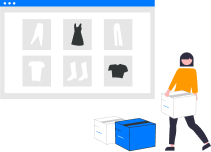
Ecommerce Vs Retail: What’s The Fundamental Differences?
Retail and online shopping are the two most influential actors in the current business environment, constantly shifting and developing. While both avenues offer opportunities for businesses to thrive, what are the fundamental differences between Ecommerce Vs Retail?
The fundamental differences between ecommerce and retail lie in their method of selling. Ecommerce involves online transactions through digital platforms, while retail refers to physical stores where customers purchase goods in person. These distinctions impact cost, customer experience, and market reach.
This blog post will delve deep into the core distinctions between retail and e-commerce, exploring their unique characteristics, advantages, and challenges.
What Is An Ecommerce Business?

An e-commerce business is an online enterprise selling products or services online. Unlike traditional retail stores, ecommerce businesses operate exclusively or primarily through digital platforms such as websites, mobile apps, or online marketplaces. Customers browse the company’s offerings, make purchases, and complete transactions entirely online, often with the convenience of home delivery or digital downloads.
Ecommerce businesses may range from small, independent ventures to large corporations, and they typically leverage digital marketing strategies, user-friendly websites, and secure payment gateways to attract and retain customers in the competitive online marketplace.
Types Of Ecommerce Business

Ecommerce businesses come in various forms, each catering to different markets, products, and customer needs. Here are five main types of ecommerce businesses:
Business-to-Consumer (B2C):
B2C ecommerce refers to online transactions between businesses and individual consumers. These businesses sell products or services directly to end-users through websites or online marketplaces. Examples include online retailers like Amazon, Walmart, and eBay and digital service providers like Netflix and Spotify. B2C ecommerce businesses often focus on delivering a seamless shopping experience, personalized recommendations, and convenient payment options to attract and retain customers.
Business-to-Business (B2B):
B2B ecommerce involves business transactions, where one company sells products or services to another. These transactions may include wholesale purchases, supply chain management, or procurement of business-related services. Examples of B2B ecommerce businesses include
- manufacturers selling products to retailers,
- software companies offering subscription services to businesses and
- wholesalers supplying inventory to resellers.
B2B ecommerce platforms often prioritize features such as bulk ordering, custom pricing, and integration with procurement systems to streamline business-to-business transactions.
Consumer-to-Consumer (C2C):
C2C ecommerce facilitates transactions between individual consumers, allowing them to buy and sell goods or services directly to each other through online platforms. Examples of C2C e-commerce websites include eBay, Craigslist, and Facebook Marketplace, where individuals can list items for sale, negotiate prices, and arrange for payment and delivery. C2C platforms typically provide features such as user ratings, secure payment processing, and messaging tools to facilitate trust and communication between buyers and sellers.
Consumer-to-Business (C2B):
C2B ecommerce reverses the traditional consumer-business relationship, where individuals offer products or services to businesses in exchange for payment. This model is commonly seen in freelance marketplaces, where individuals with specialized skills or expertise can offer their services to companies on a project basis. Examples include platforms like Upwork, Fiverr, and TaskRabbit, where freelancers can bid on projects, negotiate terms, and deliver services remotely. C2B ecommerce platforms often focus on features such as profile verification, project management tools, and secure payment processing to facilitate transactions between consumers and businesses.
Mobile Commerce (M-commerce):
M-commerce refers to ecommerce transactions conducted through mobile devices such as smartphones and tablets. With the increasing prevalence of mobile technology, many e-commerce businesses have adapted their platforms to offer mobile-friendly experiences for customers. M-commerce encompasses various activities, including mobile shopping apps, mobile payments, and location-based services. Examples include mobile apps from retailers like Amazon and Walmart and mobile payment solutions like Apple Pay and Google Pay. M-commerce platforms prioritize features such as responsive design, mobile optimization, and seamless checkout experiences to enhance the mobile shopping experience for consumers.
What Is A Retail Business?

A retail business is a commercial enterprise selling goods or services directly to consumers for payment. Unlike wholesale or manufacturing businesses, retail establishments typically operate physical storefronts where customers can browse, select, and purchase products in person. These businesses may offer various merchandise, including clothing, electronics, groceries, furniture, etc.
Retail businesses play a crucial role in the supply chain by connecting producers or wholesalers with end-users, providing convenience and accessibility to consumers. They often prioritize location, store layout, customer service, and merchandising strategies to attract and retain customers in the competitive retail market.
Types Of Retail Channels

Retail channels represent the various pathways through which goods move from producers to end users. Here are two primary types of retail channels:
Market Distribution:
Market distribution involves an additional link in the supply chain compared to direct channels, such as physical stores. Retail establishments typically acquire merchandise from producers and manufacturers before selling it to customers in brick-and-mortar locations. These retailers may offer a diverse range of products sourced from various producers, creating a one-stop shopping experience for consumers. Additionally, online retailers may distribute the market by sourcing products from manufacturers for resale or assisting manufacturers in reselling their products on e-commerce platforms.
Direct Communication Route:
The direct communication route represents the quickest way to get products to customers, bypassing intermediaries in the supply chain. In this channel, producers and manufacturers directly interact with consumers in person or through online platforms. For example, e-commerce shops selling handmade products, such as art prints or crafted items, often utilize this strategy by selling directly to customers without involving retail intermediaries. Similarly, brick-and-mortar retailers like farmer’s markets and pop-up shops may employ direct channel sales strategies by manufacturing and distributing goods directly to consumers without traditional retail involvement.
Retail vs. eCommerce: The Fundamental Differences
Retail and eCommerce represent two distinct approaches to selling products, each with advantages and challenges. Understanding the fundamental differences between the two can help businesses determine which strategy aligns best with their needs and goals.
Target Audience:
Retail stores typically target local customers, relying on foot traffic from nearby neighborhoods and communities. These customers are often the most likely to make purchases due to their proximity and immediate access to the store’s offerings. On the other hand, eCommerce businesses have the potential to reach customers globally, transcending geographical boundaries through online platforms. This broader reach opens up opportunities to tap into diverse markets and customer segments beyond the limitations of physical location.
Responsibilities:
In retail establishments, in-person physical labor is prevalent, with employees engaged in tasks such as stocking shelves, assisting customers, and maintaining the store’s appearance. Conversely, eCommerce businesses rely heavily on digital platforms and technology for operations, with responsibilities including customer service, order fulfillment, marketing, shipping logistics, and inventory management. While both require a trained workforce, the specific duties may differ, with retail employees often handling tasks like returns, exchanges, and visual merchandising in addition to core responsibilities.
Start-up Expenses:
Launching a brick-and-mortar retail business typically entails higher start-up costs than establishing an online presence. Retail ventures face significant expenses such as leasing or purchasing a physical storefront, utilities, staffing, and store decor. These upfront investments contribute to the higher operating costs associated with traditional retail. In contrast, eCommerce businesses generally have lower overhead expenses, as they can operate without needing physical storefronts. However, they may incur costs related to website development, online marketing, and fulfillment infrastructure.
Flexibility and Scalability:
eCommerce offers greater flexibility and scalability compared to traditional retail models. Online businesses can adapt quickly to changing market conditions, adjust product offerings, and optimize real-time marketing strategies. Additionally, eCommerce platforms provide the scalability to accommodate growth without the constraints of physical space limitations. Retail stores, while offering a tangible shopping experience, may need help scaling operations due to spatial constraints and fixed infrastructure.
Customer Experience:
The customer experience differs significantly between retail and eCommerce environments. Retail stores offer a hands-on shopping experience, allowing customers to interact with products physically and receive immediate assistance from staff. In contrast, eCommerce provides convenience and accessibility, allowing customers to browse and purchase products anytime. Personalized recommendations, easy navigation, and seamless checkout processes are key to a positive online shopping experience.
Ecommerce vs Retail for Consumers

When consumers decide between e-commerce and retail, several key differences come into play, each influencing the overall shopping experience and customer satisfaction. Here’s a breakdown of seven significant distinctions between the two:
Buying Process:
- Retail: The shopping experience in brick-and-mortar stores revolves around physical interaction with products, displays, and advertisements. Customers can touch, feel, and try out items before purchasing, enhancing their overall understanding and satisfaction.
- Ecommerce: In online shopping, the purchasing process needs physical interaction. However, ecommerce companies compensate by providing extensive product information, images, videos, and customer reviews to replicate the in-store experience as closely as possible.
Assisting Customers:
- Retail: Face-to-face interaction with sales staff is a hallmark of retail shopping. Customers can receive personalized assistance, have their questions answered promptly, and address any concerns in real time.
- Ecommerce: While lacking in-person interactions, ecommerce platforms offer various customer support channels, including email, social media, and live chat. This 24/7 accessibility provides convenience and assistance to online shoppers regardless of time or location.
Convenience:
- Retail: Although retail stores offer a personalized shopping experience, they may need to catch up in convenience compared to ecommerce. However, strategic placement of advertisements and helpful sales professionals can enhance the shopping journey.
- Ecommerce: Convenience is the cornerstone of online shopping, allowing customers to purchase anytime, anywhere. User-friendly websites and mobile apps streamline the buying process, providing seamless navigation and easy checkout options.
Physical Experience:
- Retail: The physical environment of brick-and-mortar stores contributes significantly to the overall shopping experience. Customers can enjoy the ambiance, explore product displays, and tangibly engage their senses.
- Ecommerce: While lacking physical presence, ecommerce platforms leverage digital technologies to create immersive experiences through high-quality images, interactive product demos, and virtual try-on features.
Availability of Products:
- Retail: The availability of products in retail stores is limited to the physical inventory, which may vary depending on store size and location.
- Ecommerce: Online retailers can offer a vast array of products without physical space constraints, providing customers with a broader selection and greater accessibility to niche or specialty items.
Return and Exchange Process:
- Retail: In-store returns and exchanges are typically straightforward, allowing customers to resolve issues quickly and efficiently.
- Ecommerce: While online returns may require shipping items back, many ecommerce companies offer hassle-free return policies and convenient return shipping options to enhance customer satisfaction.
Community Engagement:
- Retail: Local retail stores often play a vital role in fostering community engagement and building customer relationships through events, promotions, and personalized interactions.
- Ecommerce: Although lacking physical community presence, ecommerce platforms can engage customers through online communities, social media interactions, and targeted marketing campaigns.
Ecommerce Vs Retail For Businesses

When deciding between a traditional retail store and an online e-commerce platform, businesses must carefully consider several factors to determine the most suitable approach for their operations. Here are seven key differences between the two:
Investment and Expenses:
- Both retail and ecommerce businesses require investment, which varies based on the scale of operations and the range of products or services offered.
- Establishing an online business typically requires a lower initial investment than opening a physical store. E-commerce ventures involve digital marketing tools, domain hosting, and website development expenses. On the other hand, setting up a physical store entails higher capital investment for costs like rent, utilities, insurance premiums, and interior decor.
Business Processes:
- Retail and ecommerce businesses employ different business processes to manage operations and control expenses.
- Traditional retail operations involve physical tasks like stocking shelves, managing inventory, and responding to changes in demand. In contrast, ecommerce platforms offer automation features for various retail activities, including digital marketing campaigns, inventory management, and order fulfillment. This automation streamlines operations and reduces manual intervention, leading to increased efficiency.
Customer Reach and Target Audience:
- Both retail and ecommerce businesses aim to reach their target audience and attract customers, albeit through different channels.
- Retail stores primarily target local customers who visit physical locations, relying on foot traffic and community engagement. In contrast, e-commerce businesses have the potential to reach a global audience through online platforms, leveraging digital marketing strategies and search engine optimization to expand their market reach beyond geographical boundaries.
Operational Flexibility:
- Both types of businesses require flexibility in adapting to changing market conditions and consumer preferences.
- Ecommerce platforms offer greater flexibility in scaling operations and adjusting strategies in real-time due to the digital nature of the business. With the ability to quickly modify product offerings, pricing strategies, and marketing campaigns, online retailers can respond more effectively to market trends and customer feedback. In contrast, traditional retail stores may need more scalability due to physical space constraints and fixed infrastructure.
Customer Experience:
- Providing a positive customer experience is essential for retail and e-commerce businesses to enhance satisfaction and loyalty.
- Retail stores offer a tactile shopping experience, allowing customers to interact with products physically and receive personalized assistance from sales staff. Ecommerce platforms focus on providing convenience and accessibility through user-friendly interfaces, seamless navigation, and efficient checkout processes. Additionally, online retailers utilize features such as product reviews, recommendations, and virtual try-ons to enhance the digital shopping experience.
Market Competition:
- Both retail and ecommerce businesses must contend with competition within their respective markets.
- Ecommerce businesses face intense competition from other online retailers, requiring effective digital marketing strategies and differentiation to stand out. Retail stores may face competition from neighboring businesses within the local community, necessitating unique value propositions, customer engagement tactics, and store experiences to attract and retain customers.
Scalability and Growth Potential:
- Both types of businesses seek opportunities for growth and expansion over time.
- Ecommerce businesses typically have higher scalability potential due to the digital nature of operations, allowing for rapid growth and expansion into new markets without physical infrastructure constraints. Online retailers can easily adjust inventory levels, add new product categories, and target niche markets to capitalize on emerging opportunities. In contrast, traditional retail stores may need more support scaling up due to physical space constraints, although strategic initiatives such as opening additional locations or franchising can facilitate growth.
Benefits Of Ecommerce

Engaging in ecommerce offers several advantages that make it an attractive option for startups. Here are six key benefits of operating an online business:
Low Initial and Ongoing Expenses:
Establishing an ecommerce business requires minimal upfront investment compared to traditional brick-and-mortar stores. Online companies do not need a physical location, reducing rent or property purchase expenses. Moreover, setting up an ecommerce website or utilizing existing shopping platforms is cost-effective and accessible, allowing startups to establish their online presence without significant financial resources. Additionally, e-commerce businesses can save on marketing costs by leveraging digital channels, such as social media and online advertisements, rather than traditional methods like flyers or billboards.
Convenience:
Online shopping offers unparalleled convenience for customers, allowing them to browse and purchase products from the comfort of their homes or on the go. The ease of online shopping enables customers to explore products at their leisure, compare prices, and make informed purchasing decisions without physical store hours or location constraints. Furthermore, ecommerce businesses often provide convenient customer service options such as live chat, email assistance, and phone support, enhancing the overall shopping experience for customers.
Wide Audience Reach:
Ecommerce businesses have the potential to reach a global audience, transcending geographical boundaries and time zones. By operating online, businesses can access consumers worldwide, expanding their customer base and revenue opportunities. The 24/7 availability of Internet shopping enables customers to access products at any time, regardless of location or time zone. This extensive audience reach allows ecommerce businesses to leverage word-of-mouth advertising and refine their marketing strategies to cater to diverse customer preferences.
Scalability and Flexibility:
Ecommerce businesses offer scalability and flexibility, allowing startups to quickly adapt to changing market conditions and consumer demands. Online platforms can easily accommodate growth by scaling up infrastructure and expanding product offerings without physical space constraints. Additionally, e-commerce businesses can adjust pricing strategies, promotional campaigns, and product assortments in real time to optimize sales and profitability, enabling agile responses to market trends and competitor activities.
Data Analytics and Insights:
Ecommerce platforms provide valuable data analytics and insights that empower businesses to make informed decisions and optimize performance. By tracking website traffic, customer behavior, and sales metrics, ecommerce businesses can identify trends, measure campaign effectiveness, and personalize the shopping experience for customers. Data-driven insights enable companies to refine their marketing strategies, enhance product offerings, and improve customer satisfaction, driving long-term success and growth.
Reduced Geographic Limitations:
Unlike brick-and-mortar stores, ecommerce businesses are not bound by geographic limitations. Customers from anywhere in the world can access products and make purchases online, eliminating the need for physical proximity to target markets. This expanded reach allows ecommerce businesses to tap into niche markets, target specific demographics, and capitalize on global trends, maximizing revenue potential and market opportunities.
Benefits Of Retail Business

Retail businesses offer several benefits that contribute to their enduring popularity and success. Here are six key advantages of operating a retail business:
Low Delivery Expenses:
Retail stores typically offer products directly to customers in-store, eliminating the need for expensive shipping costs associated with online purchases. Both retailers and customers benefit from reduced shipping expenses, as the final price customers pay includes only the product’s quoted price and any applicable sales tax. This streamlined purchasing process encourages repeat purchases and fosters customer loyalty, as customers can shop without the concern of incurring additional shipping fees.
Interaction with Customers:
Retail stores provide opportunities for direct interaction between company representatives and customers. From store managers to sales associates, staff members can engage in one-on-one conversations with shoppers, offering assistance, product recommendations, and personalized service. This customized interaction enhances the shopping experience, builds customer trust and rapport, and increases the likelihood of repeat business and positive word-of-mouth referrals.
Real Items:
Retail stores offer tangible, physical products that customers can see, touch, and try before purchasing. This hands-on experience allows customers to evaluate product quality, functionality, and suitability firsthand, reducing the likelihood of returns and exchanges. For example, customers can test furniture for comfort or try on clothing for fit, leading to more informed purchasing decisions and higher satisfaction levels. Additionally, physical products can be immediately available for purchase, eliminating the need to wait for delivery and meeting customers’ immediate needs.
Immediate Gratification:
Retail stores provide customers the immediate gratification of obtaining products on the spot. Unlike online purchases that require shipping and delivery times, retail purchases allow customers to take possession of items immediately after payment. This instant gratification enhances the overall shopping experience, particularly for items needed urgently or for impulse purchases, contributing to customer satisfaction and loyalty.
Visual Merchandising Opportunities:
Retail stores offer opportunities for creative visual merchandising, allowing businesses to showcase products in engaging and visually appealing ways. Effective merchandising strategies, such as eye-catching displays, product demonstrations, and themed showcases, can attract customer attention, drive sales, and enhance brand perception. Well-designed retail environments create memorable shopping experiences that differentiate businesses from competitors and encourage repeat visits.
Community Engagement:
Retail stores serve as community hubs, fostering social interactions and engagement among customers and residents. By hosting events, workshops, and promotions, retail businesses can strengthen connections with the community, build brand loyalty, and generate positive word-of-mouth referrals. Community engagement initiatives demonstrate a commitment to local causes and values, positioning retail businesses as integral community members and enhancing their reputation and customer relationships.
Should I Expand Into Ecommerce?

Expanding into e-commerce can offer numerous benefits for businesses, but it’s essential to carefully consider several factors before leaping into it. Here are five key points to keep in mind:
Cost:
Assess the potential expenses associated with ecommerce expansion, including initial investment and ongoing maintenance fees for the chosen platform. Whether you opt for an in-house solution, open-source platform, or software as a service, ensure that your budget can cover the project’s expenses before proceeding.
Company Structure:
Evaluate whether your current business model is conducive to transitioning from brick-and-mortar to online sales. Consider whether your company primarily deals with other businesses or individual consumers. Different forms of ecommerce may be more suitable depending on your target audience and existing operations. Ensure that your company can adapt to the shift and maintain its core principles, especially if customer service is a significant aspect of your business.
Company Size:
Consider the size and scope of your business before implementing ecommerce initiatives. Evaluate whether your products are well-suited for online sales and whether your company has the necessary resources and infrastructure to support ecommerce operations. While ecommerce can benefit small businesses with a strong web presence or aspirations for expansion, it may only be suitable for some businesses. Determine the scale of growth you aim to achieve and whether ecommerce aligns with your strategic objectives.
Market Potential:
Conduct thorough market research to assess the potential demand for your products or services in the ecommerce space. Analyze consumer preferences, competitor strategies, and market trends to identify opportunities and possible challenges. Determine whether there is a viable market for your offerings online and whether ecommerce expansion aligns with your long-term growth objectives.
Technical Expertise:
Consider whether your team has the technical expertise to manage ecommerce operations effectively. Evaluate whether you have the skills and resources to develop and maintain a robust ecommerce platform, including website design, digital marketing, and customer support. Assess whether additional training or hiring external expertise may be necessary to support your ecommerce initiatives effectively.
FAQs
What Are The Main Differences Between Ecommerce And Retail?
The main differences between ecommerce and retail lie in the method of selling. Ecommerce involves online transactions conducted through websites or digital platforms, while retail refers to physical stores where customers purchase goods in person.
Which Is More Cost-Effective, Ecommerce Or Retail?
Ecommerce is typically more cost-effective than retail due to lower overhead costs associated with physical storefronts. Online businesses save on rent, utilities, and staffing expenses, allowing for higher profit margins.
How Do Customer Preferences Differ Between Ecommerce And Retail?
Customer preferences vary between ecommerce and retail based on convenience, product availability, and shopping experience. While some customers prefer the convenience of online shopping, others value the tactile experience and personalized service offered by retail stores.
Which Channel Offers A Wider Reach, Ecommerce Or Retail?
Ecommerce offers a wider reach than retail because it can reach customers globally through online platforms. Retail stores are limited by geographic location and foot traffic, whereas ecommerce businesses can access customers worldwide.
What Are The Advantages Of Brick-And-Mortar Retail Over Ecommerce?
Brick-and-mortar retail offers advantages such as immediate gratification, hands-on product experience, and face-to-face interaction with sales staff. Additionally, retail stores can provide instant customer assistance and personalized service.
How Does The Level Of Competition Differ Between Ecommerce And Retail?
Ecommerce faces intense competition from other online retailers, requiring businesses to differentiate through pricing, product quality, and customer experience. Retail stores may also face competition, but often within a localized market, allowing for more targeted strategies.
What Are The Trends Shaping The Future Of Ecommerce And Retail?
The future of ecommerce and retail is influenced by trends such as omnichannel shopping experiences, mobile commerce, and augmented reality technologies. Both channels increasingly integrate digital innovations to enhance customer engagement and streamline operations in response to evolving consumer preferences.
Work With Experts in Ecommerce Marketing
We specializes in web design, Shopify development, WooCommerce development, and search engine optimization for ecommerce businesses. Our expertise in these areas enables us to offer world-class digital marketing solutions tailored to your needs. As a full-service digital marketing firm, we can help your company expand by constructing a customized online shop that maximizes visibility and drives sales. With our team of experts, you can trust Oyolloo to elevate your ecommerce marketing strategy and achieve your business goals effectively and efficiently.

















































